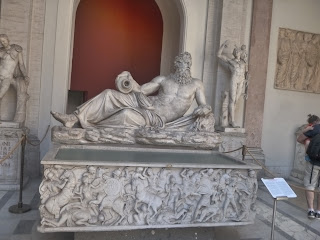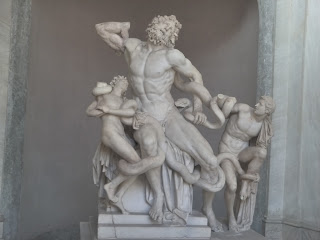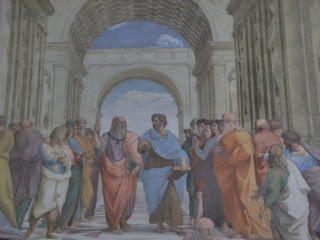
Michelangelo-Last-Judgement
While Robert Hughes advises against it, I have never been to Rome without paying a visit to St Peter’s Basilica in the Vatican. I always find the experience both awe inspiring and a bit ominous. We got special tickets, trying to beat the crowds through the Vatican Museo. But it wasn’t too be. By the time we got there, a zillion of the others who’d had the same idea were also there.
I love the art inside, the Bronchusi dome and the School of Athens by Rafael. The map rooms and the other zillions of work still inspire. But as the years go by, I’m more and more aware of the use of the culture to codify power and authority.
Its own country, the Vatican receives some ten billion dollars in subsidies from the state of Italy every year. Few of the dollars coming into the Vatican among art fans hoping to catch a glimpse of the ceiling of the Sistine Chappell go the other way.
“Good for paying off lawsuits,” I mumbled to Caroline.
“Leave your New York cynicism behind,” she shot back.
“Remember what Louis C K said about the Catholics?” I smiled. (Hint, the whole thing is about sex with young boys).
“I know. Shhh..”
The tour guide tells us the kids have their own entrance, away from the parents.
“They don’t trust us,” he explains.
“Make sure they don’t touch you or give you iris scans,” I warn the kids.
Horrible thoughts start running through my mind.
We eventually meet up with the kids again.
Still the tour guide walks the line between representing the Vatican position and the historical record of stories of the use of culture as social control. When Martin Luther proposed that the world translate the bible into German, the church suggested those not on board would not be recognized by the Catholic Church.
More and more of this culture has been subject to censorship explains our amicable tour guide, walking the line between the Vatican and the history of art.
He frames the story in terms of the history of Rome, its expansion, contraction, and eventual decline, leaving a vacuum. “Rome fell because of a crisis of the city,” our guide explained. “People were starving so they left, moving to the countryside only to return during the Renaissance. The Coliseum was a monument to an unfair, socially stratified culture. The poor people of Rome helped support the Emperor. The rich paid no taxes. The poor helped rebuild the city time and time again. It burned down decade after decade. When an oil lamp caused a big fire, Nero looked for a scapegoat, the early Christians, who pushed back. Eventually Nero was killed. We need to thank the oil lamp.
So we toured the arts and maps and sculpture of the space.
“What is unique about this fresco of god giving life to Adam?” asked our tour guide.
“That God is wearing pink?” I replied.
“That’s because he was glamorous,” our tour guide followed.
And we walked into the Sistine Chapter, where we explored the imagery of the last judgement and the majestic ceiling and its stories of the separation of light from darkness, water from land, and the expulsion of Adam and Eve from the garden..
“That might have been the most liberating moment of her life,” mused Caroline.
I have never had this much time to explore this many details of the work, looking at details of the people consumed at the bottom of last judgement, the man being attacked by a snake, others falling from the sky.
The guards seemed to circle everyone.
And we made our way through the entire exhibition. Its always moving to see Plato pointing up and Aristotle pointing down in the School of Athens by Raphael. Its an old friend. I have always had an affinity for Raphael, who passed in his late thirties. Only the good die young. Walking out I looked back at the old masterwork, not sure I’ d see her again and we made our way out.
“So what did you learn from the experience,” we asked the kids.
“That its good to be the pope,” mused number two, humming the tune from Mel Brooks History of the World.
Here are some photos.






















































































































No comments:
Post a Comment